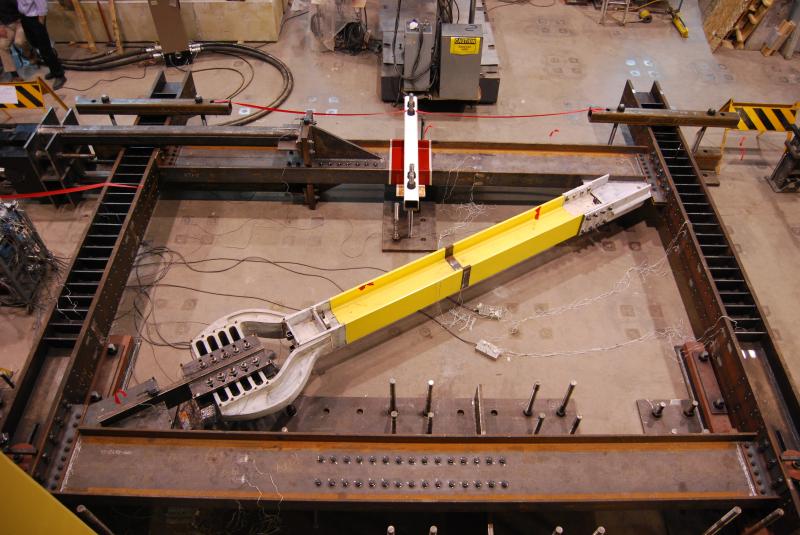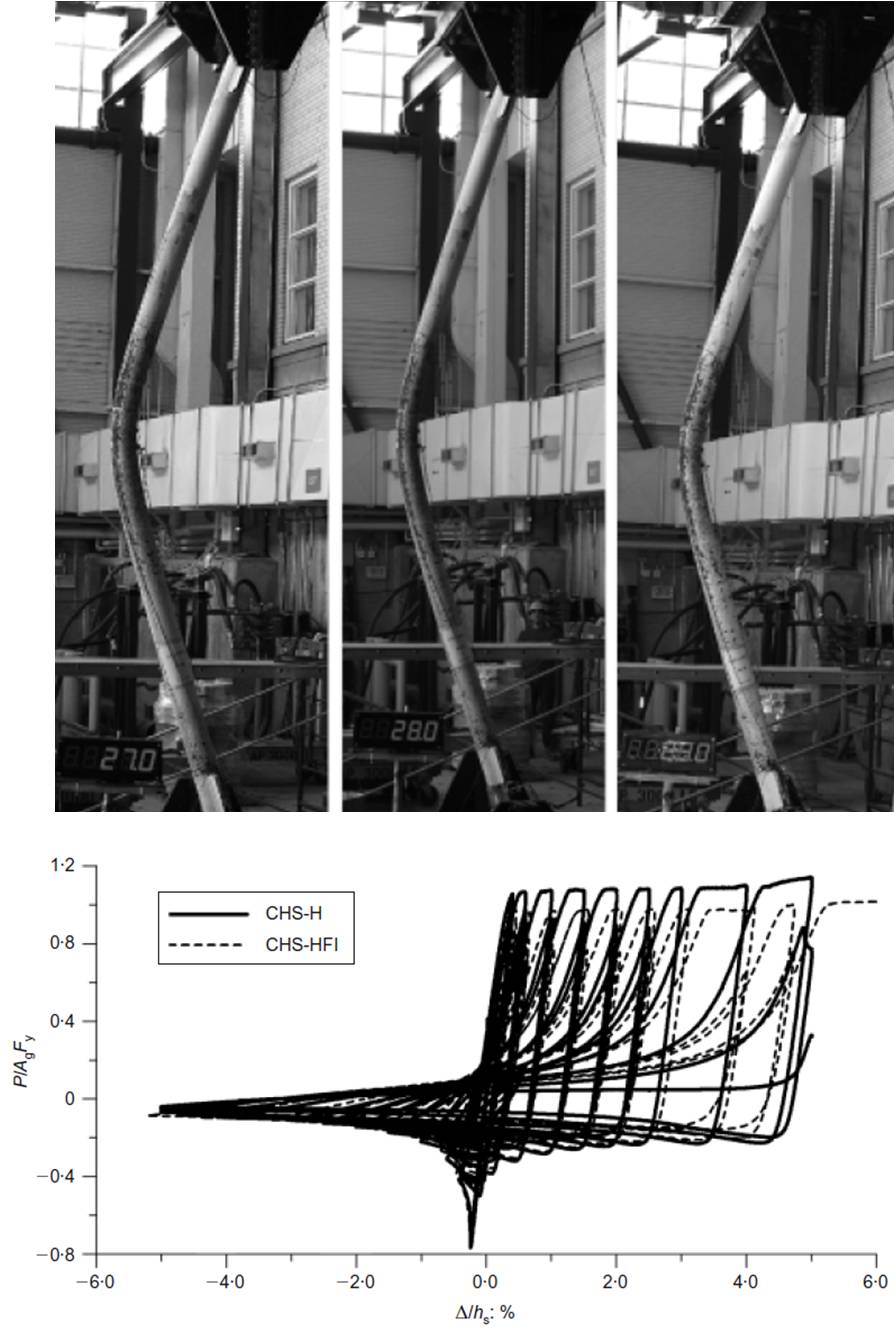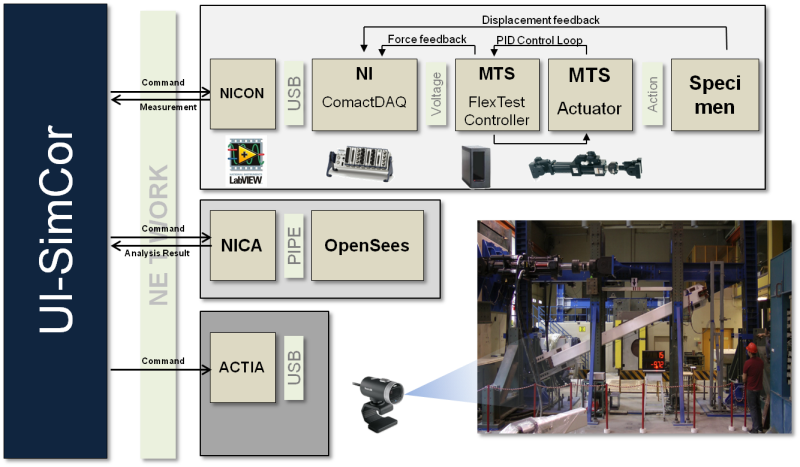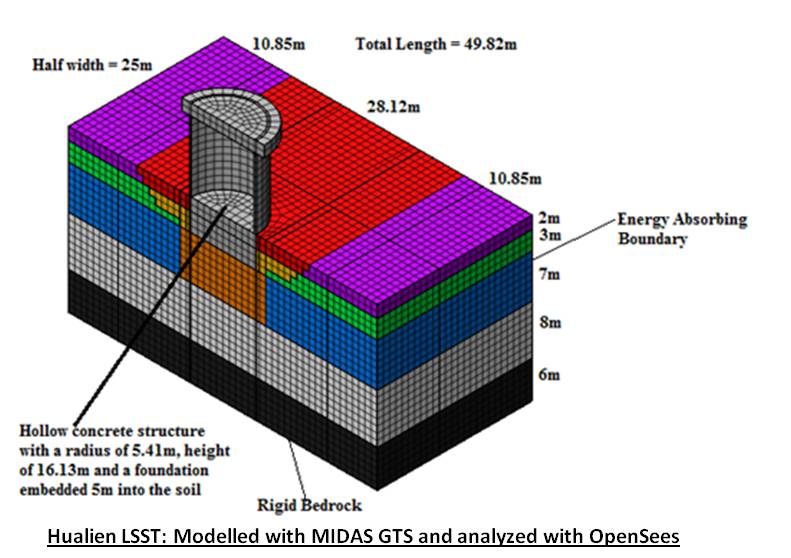Research Related to Numerical and Hybrid Testing
Evaluation of a CANDU Containment Structure Subjected to Long-term and Beyond-Design Level Loads
Hybrid Simulation of a Steel Frame with SCED Braces
Seismic Related Research
Self-Centring Energy Dissipative Bracing System
Design of Controlled Rocking Steel Frames to Limit Higher Mode Effects
Influence of Material Property on Seismic Performance of Hollow Steel Section
Evaluation of a CANDU Containment Structure Subjected to Long-term and Beyond-Design Level Loads
With the support of Candu Owner’s Group through Candu Energy, Inc., the structural performance of CANDU containment structure is being evaluated considering various time-dependent parameters and beyond-design level loads. In the first year (2013-2014) of the project, a typical CANDU containment structure was modelled using VecTor4, and the effects of time-dependent parameters, such as shrinkage, creep, and relaxation, are considered. The internal pressure is increased until the containment structure develops mechanism. In the second and third years (2014-2016), laboratory tests will be carried out to refine the shrinkage and creep model of concrete when the concrete is subjected to low-humidity environment similar to the internal environment of a typical CANDU containment structure. In addition, the dynamic impedance properties of soil-foundation system will be integrated with the containment structure such that nonlinear time-domain analysis of the containment structure can be carried out in a computationally efficient manner considering the inertial soil-structure interaction. Ultimately, a complete nonlinear numerical model of a nuclear power plant system, including equivalent-linear soil-foundation system, will be developed. The integrated numerical model will allow the analysis of a nuclear power plant subjected to beyond-design level load and subsequent increase of internal pressure as observed in 2011 Tohoku Earthquake.
Researchers: Xu Huang, Prof. Kwon, Prof. Bentz, Prof. Christopoulos, Prof. Collins
Hybrid Simulation of a Steel Frame with SCED Braces
System level performance of a six-storey structure with SCED braces was validated through PsD hybrid simulation. The six-storey structure is divided into two substructures. The SCED brace on the first floor of a six-storey structure is physically tested while the rest of the structure is numerically modelled. The interaction between the two substructures during earthquake excitations is taken into account through PsD hybrid simulation utilizing UI-SimCor. All experiments were completed in May 2012 and results are being processed for publication.
Student: Viswanath Kammula, Advisor: Prof. Kwon
Self-Centring Energy Dissipative Bracing System
In the last decade, a focus on the use of performance-based design methodologies in earthquake engineering has resulted in the development of a number of different lateral force resisting systems for buildings that aim to minimize or eliminate any residual lean after an earthquake. One such system, the Self-Centring Energy-Dissipative (SCED) brace was developed at the University of Toronto and Ecole Polytechnique in Montreal. This system contains a self-Centring mechanism that fits entirely into the form factor of a typical cross-brace and completely prevents residual lean.
Three studies have been recently conducted to improve and extend upon the original SCED concept. First, shake table testing of a three-storey SCED-braced frame confirmed the brace’s suitability in multi-storey frames and confirmed that the nonlinear modelling of these frames provides good predictions of their dynamic behaviour. Second, to extend the strength capacity of SCED braces and to refine the design procedure, a SCED prototype with a 3000kN axial load capacity was successfully designed and tested. Third, the elongation capacity of the SCED brace was doubled using a novel telescoping SCED mechanism. A prototype of this telescoping (T-SCED) brace was successfully designed and tested in a full scale single-storey steel frame.
T-SCED Dynamic Protocol Test – YouTubeStudent: Jeff Erochko, Advisor: Prof. Christopoulos
Design of Controlled Rocking Steel Frames to Limit Higher Mode Effects
Current seismic design practice results in structures that are damaged and may need to be demolished following design-level seismic events. Events like the recent Christchurch earthquake sequence have demonstrated the need for seismic force resisting systems that can improve community resilience by avoiding structural damage and residual deformations, without greatly increasing the initial cost of construction. Controlled rocking steel frames have been proposed as one such system. In a controlled rocking steel frame, rather than rigidly fixing the structure to the foundation, uplift is permitted at selected locations. This limits the peak seismic forces without structural damage, while post-tensioning and energy dissipation are used to control the peak response. Past research on rocking systems has suggested that they may lead to very large floor acceleration demands. Research published in a CRCI report, as well as two journal articles, has shown that these floor acceleration spikes may be exaggerated by numerical modelling assumptions. Past research on controlled rocking steel frames has shown that the frame design forces are heavily influenced by the effects of the higher modes. Two new concepts have been proposed for controlling higher mode effects by using multiple mechanisms. These concepts were validated through extensive large-scale shake table testing at Ecole Polytechnique of a 9.3m tall model of an 8-storey frame.
Video clip of controlled rocking testStudent: Lydell Wiebe, Advisor: Prof. Christopoulos
Validation of Nonlinear Time Domain Analysis Method for SSI Analysis based on Measurement from Hualien LSST
Seismic soil-structure-interaction analysis of nuclear power plant structures has been mainly carried out using equivalent linear analysis method. In the equivalent linear analysis method, the nonlinearity of soil is approximately considered by iteratively adjusting shear modulus and damping ratio of soil. The equivalent linear method is computationally effective and has been the preferred method of analysis in geotechnical engineering. If a structure is subjected to a beyond-design basis earthquake which can result in large inelastic soil response, it is essential to understand the validity of equivalent-linear approach through more sophisticated analysis, such as Nonlinear-Time History Method (NLTH). The NLTH analysis ensures equilibrium in each time step and can incorporate more complicated yet realistic constitutive models. In this project, the NLTH analysis method is verified against theoretical solution and equivalent linear method using an industry-standard program, SASSI. Both NLTH analysis method and equivalent linear analysis method is validated against Hualien Large Scale Seismic Test (LSST) in Taiwan. The validated models will be used to understand the discrepancy of the solutions from equivalent linear method and NLTH method when the soil-structure system is subjected to beyond design-basis earthquake.
Student: John Kabanda, Advisor: Prof. Kwon
Yielding Brace System
Highly ductile, seismic resistant bracing systems are an economical means of improving seismic performance for low and mid-rise building structures. These types of braced frames have become prevalent in regions of high seismicity, such as California. The Yielding Brace System is a new type of high ductility brace that was developed at the University of Toronto. In this system, seismic energy is absorbed through the plastic deformation of specially design yielding fingers of a cast steel connector. The connector is easily welded to the end of a standard structural steel W-section brace at one end and a traditional beam-column gusset plate connection at the other end.
Containing the inelastic response within a brace connector allows this technology to be mass produced and has the advantage of uncoupling the seismic performance of the brace from the geometry of the structural frame. A single device design can be used for a variety of building configurations. The Yielding Brace System is characterized by a post-yield increase in stiffness that works against second order effects that can lead to the collapse of traditional high ductility bracing systems.
Work conducted at the University of Toronto included material characterization tests to enable the design of a prototype YBS device, component testing of the prototype connector, full-scale testing of a braced frame equipped with the Yielding Brace System and a non-linear numerical study of a sample structure validating the a proposed design methodology for the YBS. The product of this research is now being commercialized by a Canadian start-up company, Cast Connex.
Student: Michael Gray, Advisor: Professors Christopoulos and Packer

Influence of Material Property on Seismic Performance of Hollow Steel Section

Hollow structural sections for onshore steel construction are manufactured in diverse locations around the world, by either a hot-finishing or seamless process or – far more commonly – by cold-forming. The implications of using material by a particular process in various statically loaded or dynamically loaded applications are not fully appreciated. This research hence reviews some of the key geometric and material properties that are inherent in several common hollow section production standards. Problems that have been encountered with certain coldformed square and rectangular hollow sections, particularly with regard to hot-dip galvanising in North America and Asia, are elaborated. Besides galvanising, these same sections are now also subject to constraints for seismic applications. The difference in seismic performance between cold-formed, cold-formed and stress-relieved, and hot-finished hollow sections, when used as energy-dissipating members such as braces, has been a point of debate and speculation to date. An experimental project is carried out in which the relative performance of each material type is evaluated by performing inelastic cyclic testing of large-scale tubular braces.
Nonlinear Analysis of Soil-Structure-Interaction Systems Using Transformation of Dynamic Impedance Functions
The soil-structure-interaction (SSI) effect for safety-critical structures, such as nuclear power plants, has been primarily considered through frequency domain analysis using equivalent-linear approach. If a structure behaves in inelastic range, however, it is inevitable to run non-linear time domain analysis. In this case, the soil and foundation system should be represented as discrete elements with appropriate energy absorbing boundary, which involves extensive modeling efforts and computation time. A number of methods have been proposed in literature that allow for frequency dependent systems to be modeled in the time domain analysis. Some of the methods include 1) a convolution integration of a unit impulse response function (inverse FFT of impedance function), 2) equivalent mass-stiffness-damper system with fewer number of DOFs, 3) modeling of soil-foundation with unit displacement and velocity response functions, 4) using a digital filter algorithm to represent frequency dependent behavior, etc. These methods, however, do not always result in accurate and stable response when combined with a time integration scheme. The main objective of this research is to develop a robust algorithm which allows accurate yet stable analysis of nonlinear structure – equivalent linear soil – interacting system.
Student: Alex Duarte-Laudon, Advisor: Professors Oh-Sung Kwon




